Heritage Valley Medical Center: Cultural Diversity Case Study Analysis
VerifiedAdded on 2023/04/17
|7
|1684
|239
Case Study
AI Summary
This case study analyzes the Heritage Valley Medical Center, which aims to provide quality healthcare to a diverse community including Caucasians, Hispanics, and African Americans. The study reveals disparities in service quality and job opportunities, with Caucasians dominating the staff and executive positions. It highlights issues such as disrespect from nursing staff towards minority patients and a lack of cultural competency. The analysis evaluates the performance of different staff members, particularly managers, based on their ability to address patient needs and promote inclusivity. Recommendations are made to improve cultural sensitivity, including language programs and staff training, to enhance patient satisfaction and achieve the medical center's goals. The study emphasizes the importance of ethical practices, diversity recognition, and patient-centered care within the healthcare environment.
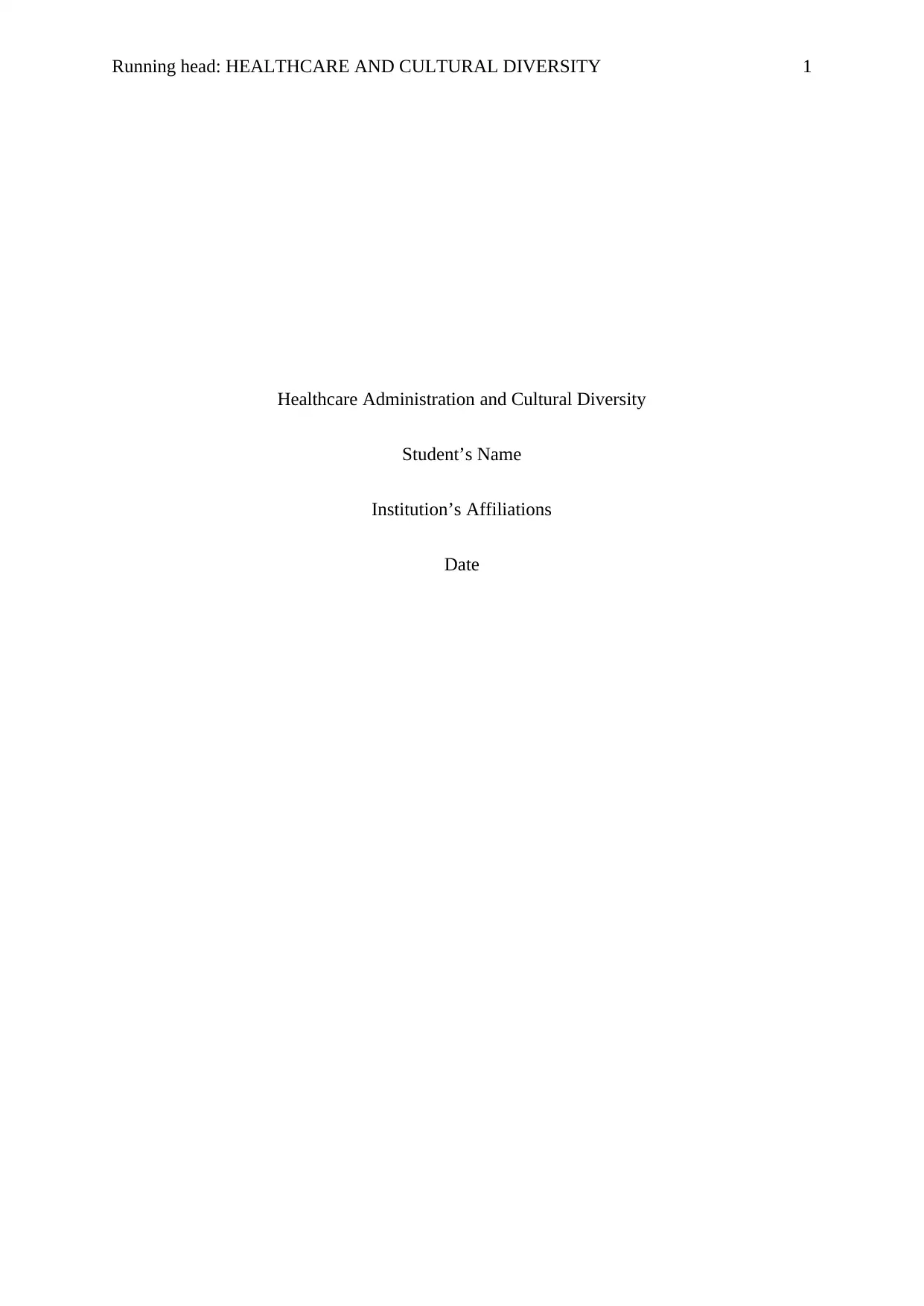
Running head: HEALTHCARE AND CULTURAL DIVERSITY 1
Healthcare Administration and Cultural Diversity
Student’s Name
Institution’s Affiliations
Date
Healthcare Administration and Cultural Diversity
Student’s Name
Institution’s Affiliations
Date
Paraphrase This Document
Need a fresh take? Get an instant paraphrase of this document with our AI Paraphraser
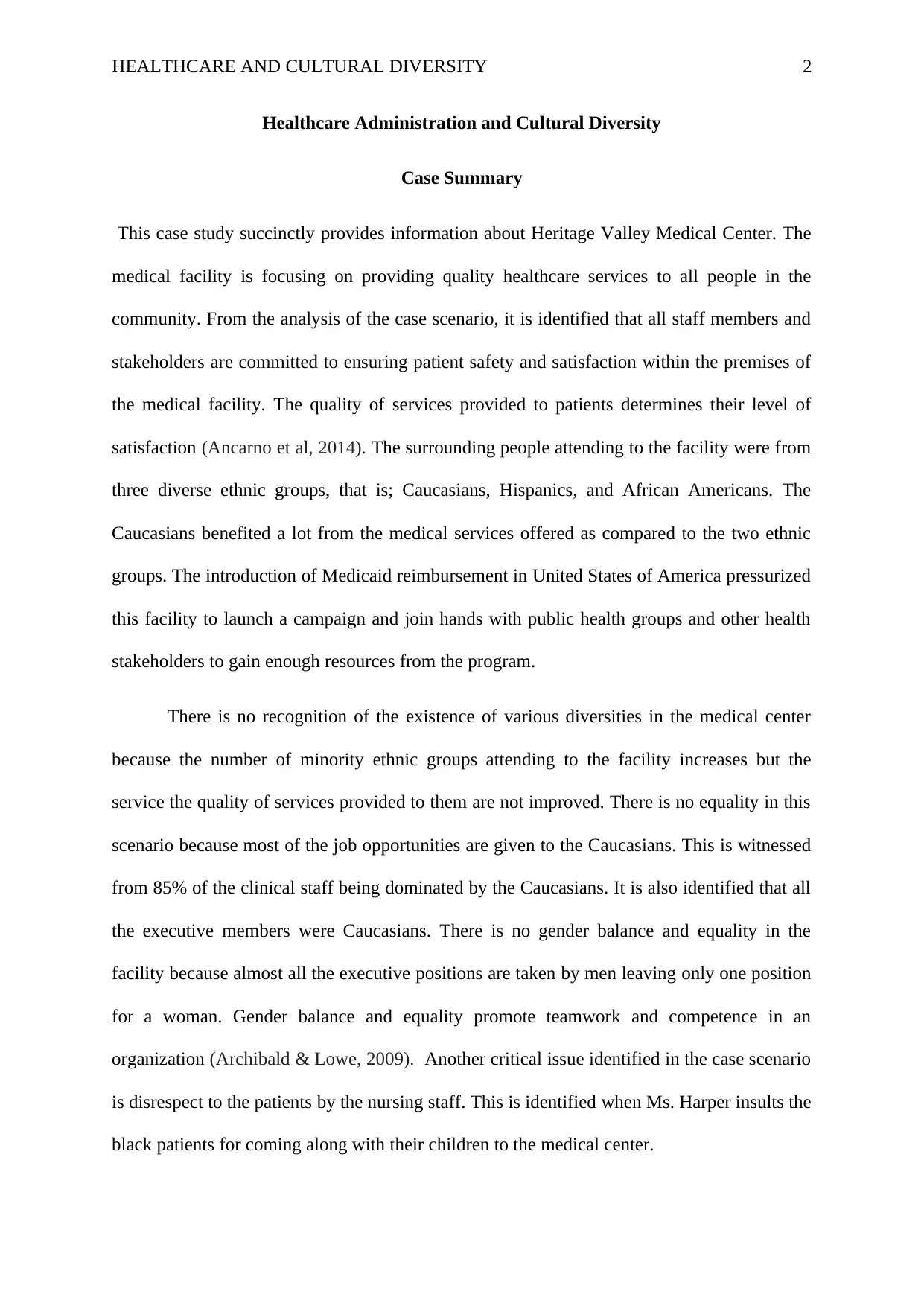
HEALTHCARE AND CULTURAL DIVERSITY 2
Healthcare Administration and Cultural Diversity
Case Summary
This case study succinctly provides information about Heritage Valley Medical Center. The
medical facility is focusing on providing quality healthcare services to all people in the
community. From the analysis of the case scenario, it is identified that all staff members and
stakeholders are committed to ensuring patient safety and satisfaction within the premises of
the medical facility. The quality of services provided to patients determines their level of
satisfaction (Ancarno et al, 2014). The surrounding people attending to the facility were from
three diverse ethnic groups, that is; Caucasians, Hispanics, and African Americans. The
Caucasians benefited a lot from the medical services offered as compared to the two ethnic
groups. The introduction of Medicaid reimbursement in United States of America pressurized
this facility to launch a campaign and join hands with public health groups and other health
stakeholders to gain enough resources from the program.
There is no recognition of the existence of various diversities in the medical center
because the number of minority ethnic groups attending to the facility increases but the
service the quality of services provided to them are not improved. There is no equality in this
scenario because most of the job opportunities are given to the Caucasians. This is witnessed
from 85% of the clinical staff being dominated by the Caucasians. It is also identified that all
the executive members were Caucasians. There is no gender balance and equality in the
facility because almost all the executive positions are taken by men leaving only one position
for a woman. Gender balance and equality promote teamwork and competence in an
organization (Archibald & Lowe, 2009). Another critical issue identified in the case scenario
is disrespect to the patients by the nursing staff. This is identified when Ms. Harper insults the
black patients for coming along with their children to the medical center.
Healthcare Administration and Cultural Diversity
Case Summary
This case study succinctly provides information about Heritage Valley Medical Center. The
medical facility is focusing on providing quality healthcare services to all people in the
community. From the analysis of the case scenario, it is identified that all staff members and
stakeholders are committed to ensuring patient safety and satisfaction within the premises of
the medical facility. The quality of services provided to patients determines their level of
satisfaction (Ancarno et al, 2014). The surrounding people attending to the facility were from
three diverse ethnic groups, that is; Caucasians, Hispanics, and African Americans. The
Caucasians benefited a lot from the medical services offered as compared to the two ethnic
groups. The introduction of Medicaid reimbursement in United States of America pressurized
this facility to launch a campaign and join hands with public health groups and other health
stakeholders to gain enough resources from the program.
There is no recognition of the existence of various diversities in the medical center
because the number of minority ethnic groups attending to the facility increases but the
service the quality of services provided to them are not improved. There is no equality in this
scenario because most of the job opportunities are given to the Caucasians. This is witnessed
from 85% of the clinical staff being dominated by the Caucasians. It is also identified that all
the executive members were Caucasians. There is no gender balance and equality in the
facility because almost all the executive positions are taken by men leaving only one position
for a woman. Gender balance and equality promote teamwork and competence in an
organization (Archibald & Lowe, 2009). Another critical issue identified in the case scenario
is disrespect to the patients by the nursing staff. This is identified when Ms. Harper insults the
black patients for coming along with their children to the medical center.
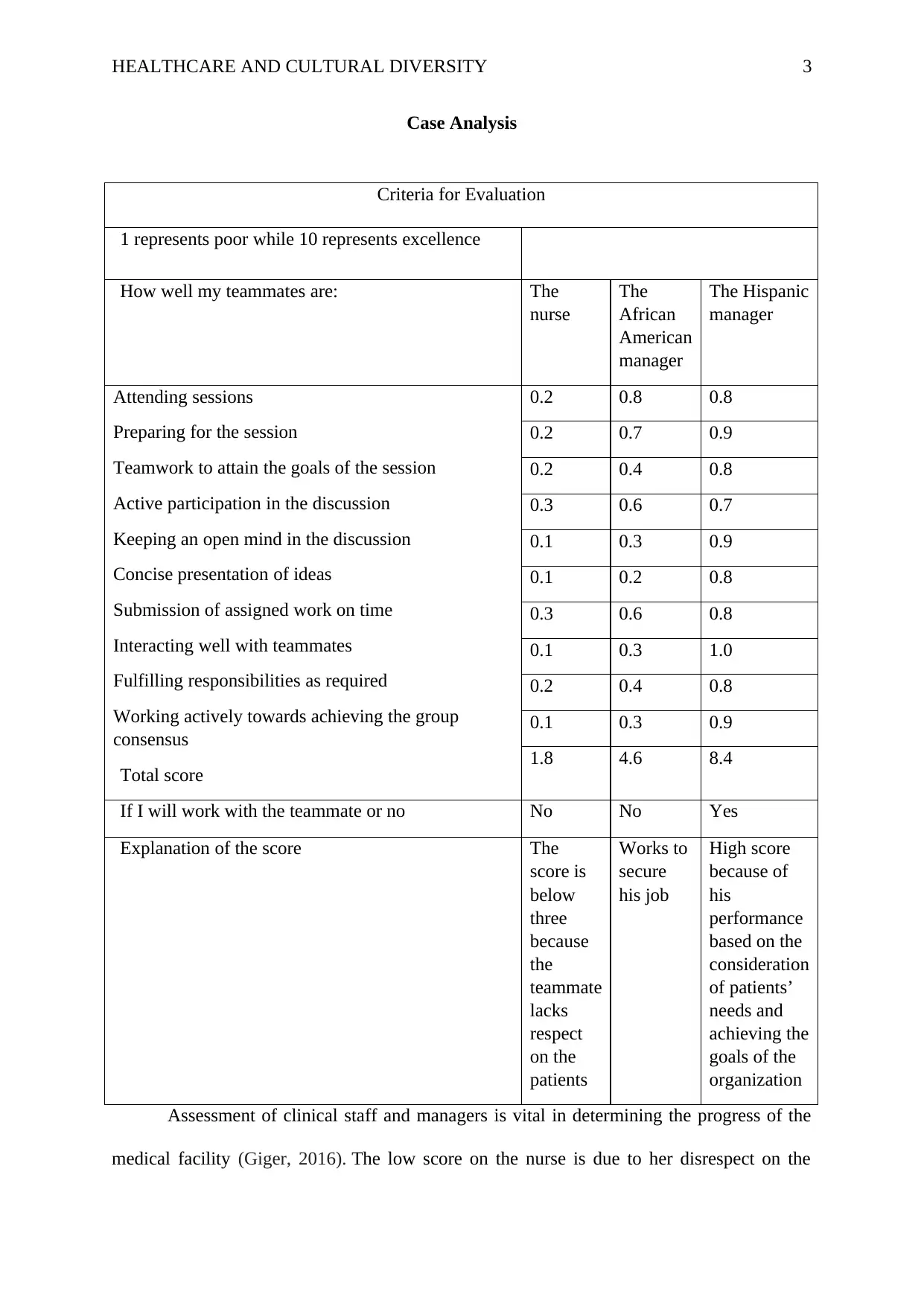
HEALTHCARE AND CULTURAL DIVERSITY 3
Case Analysis
Criteria for Evaluation
1 represents poor while 10 represents excellence
How well my teammates are: The
nurse
The
African
American
manager
The Hispanic
manager
Attending sessions
Preparing for the session
Teamwork to attain the goals of the session
Active participation in the discussion
Keeping an open mind in the discussion
Concise presentation of ideas
Submission of assigned work on time
Interacting well with teammates
Fulfilling responsibilities as required
Working actively towards achieving the group
consensus
Total score
0.2 0.8 0.8
0.2 0.7 0.9
0.2 0.4 0.8
0.3 0.6 0.7
0.1 0.3 0.9
0.1 0.2 0.8
0.3 0.6 0.8
0.1 0.3 1.0
0.2 0.4 0.8
0.1 0.3 0.9
1.8 4.6 8.4
If I will work with the teammate or no No No Yes
Explanation of the score The
score is
below
three
because
the
teammate
lacks
respect
on the
patients
Works to
secure
his job
High score
because of
his
performance
based on the
consideration
of patients’
needs and
achieving the
goals of the
organization
Assessment of clinical staff and managers is vital in determining the progress of the
medical facility (Giger, 2016). The low score on the nurse is due to her disrespect on the
Case Analysis
Criteria for Evaluation
1 represents poor while 10 represents excellence
How well my teammates are: The
nurse
The
African
American
manager
The Hispanic
manager
Attending sessions
Preparing for the session
Teamwork to attain the goals of the session
Active participation in the discussion
Keeping an open mind in the discussion
Concise presentation of ideas
Submission of assigned work on time
Interacting well with teammates
Fulfilling responsibilities as required
Working actively towards achieving the group
consensus
Total score
0.2 0.8 0.8
0.2 0.7 0.9
0.2 0.4 0.8
0.3 0.6 0.7
0.1 0.3 0.9
0.1 0.2 0.8
0.3 0.6 0.8
0.1 0.3 1.0
0.2 0.4 0.8
0.1 0.3 0.9
1.8 4.6 8.4
If I will work with the teammate or no No No Yes
Explanation of the score The
score is
below
three
because
the
teammate
lacks
respect
on the
patients
Works to
secure
his job
High score
because of
his
performance
based on the
consideration
of patients’
needs and
achieving the
goals of the
organization
Assessment of clinical staff and managers is vital in determining the progress of the
medical facility (Giger, 2016). The low score on the nurse is due to her disrespect on the
⊘ This is a preview!⊘
Do you want full access?
Subscribe today to unlock all pages.

Trusted by 1+ million students worldwide
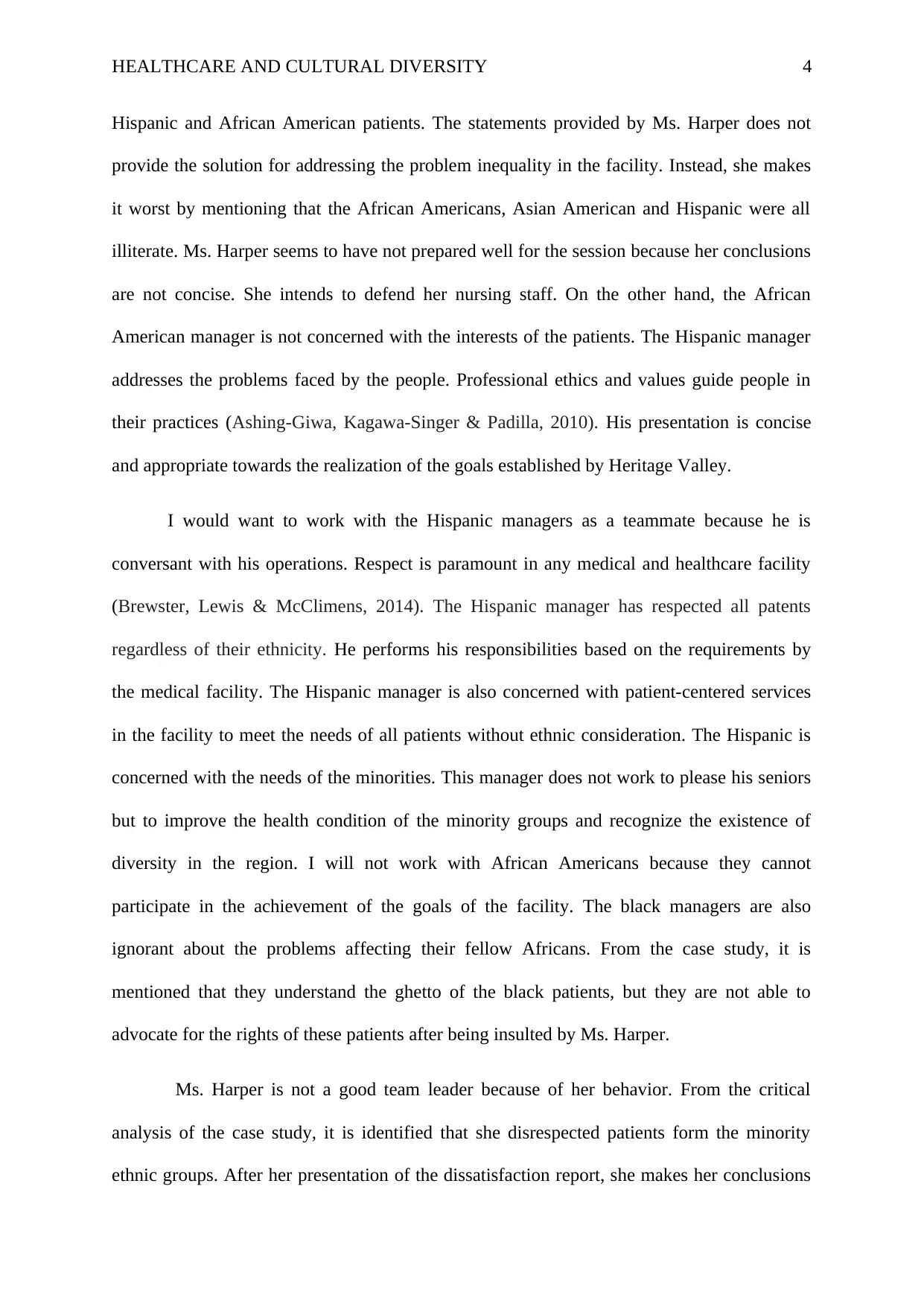
HEALTHCARE AND CULTURAL DIVERSITY 4
Hispanic and African American patients. The statements provided by Ms. Harper does not
provide the solution for addressing the problem inequality in the facility. Instead, she makes
it worst by mentioning that the African Americans, Asian American and Hispanic were all
illiterate. Ms. Harper seems to have not prepared well for the session because her conclusions
are not concise. She intends to defend her nursing staff. On the other hand, the African
American manager is not concerned with the interests of the patients. The Hispanic manager
addresses the problems faced by the people. Professional ethics and values guide people in
their practices (Ashing-Giwa, Kagawa-Singer & Padilla, 2010). His presentation is concise
and appropriate towards the realization of the goals established by Heritage Valley.
I would want to work with the Hispanic managers as a teammate because he is
conversant with his operations. Respect is paramount in any medical and healthcare facility
(Brewster, Lewis & McClimens, 2014). The Hispanic manager has respected all patents
regardless of their ethnicity. He performs his responsibilities based on the requirements by
the medical facility. The Hispanic manager is also concerned with patient-centered services
in the facility to meet the needs of all patients without ethnic consideration. The Hispanic is
concerned with the needs of the minorities. This manager does not work to please his seniors
but to improve the health condition of the minority groups and recognize the existence of
diversity in the region. I will not work with African Americans because they cannot
participate in the achievement of the goals of the facility. The black managers are also
ignorant about the problems affecting their fellow Africans. From the case study, it is
mentioned that they understand the ghetto of the black patients, but they are not able to
advocate for the rights of these patients after being insulted by Ms. Harper.
Ms. Harper is not a good team leader because of her behavior. From the critical
analysis of the case study, it is identified that she disrespected patients form the minority
ethnic groups. After her presentation of the dissatisfaction report, she makes her conclusions
Hispanic and African American patients. The statements provided by Ms. Harper does not
provide the solution for addressing the problem inequality in the facility. Instead, she makes
it worst by mentioning that the African Americans, Asian American and Hispanic were all
illiterate. Ms. Harper seems to have not prepared well for the session because her conclusions
are not concise. She intends to defend her nursing staff. On the other hand, the African
American manager is not concerned with the interests of the patients. The Hispanic manager
addresses the problems faced by the people. Professional ethics and values guide people in
their practices (Ashing-Giwa, Kagawa-Singer & Padilla, 2010). His presentation is concise
and appropriate towards the realization of the goals established by Heritage Valley.
I would want to work with the Hispanic managers as a teammate because he is
conversant with his operations. Respect is paramount in any medical and healthcare facility
(Brewster, Lewis & McClimens, 2014). The Hispanic manager has respected all patents
regardless of their ethnicity. He performs his responsibilities based on the requirements by
the medical facility. The Hispanic manager is also concerned with patient-centered services
in the facility to meet the needs of all patients without ethnic consideration. The Hispanic is
concerned with the needs of the minorities. This manager does not work to please his seniors
but to improve the health condition of the minority groups and recognize the existence of
diversity in the region. I will not work with African Americans because they cannot
participate in the achievement of the goals of the facility. The black managers are also
ignorant about the problems affecting their fellow Africans. From the case study, it is
mentioned that they understand the ghetto of the black patients, but they are not able to
advocate for the rights of these patients after being insulted by Ms. Harper.
Ms. Harper is not a good team leader because of her behavior. From the critical
analysis of the case study, it is identified that she disrespected patients form the minority
ethnic groups. After her presentation of the dissatisfaction report, she makes her conclusions
Paraphrase This Document
Need a fresh take? Get an instant paraphrase of this document with our AI Paraphraser
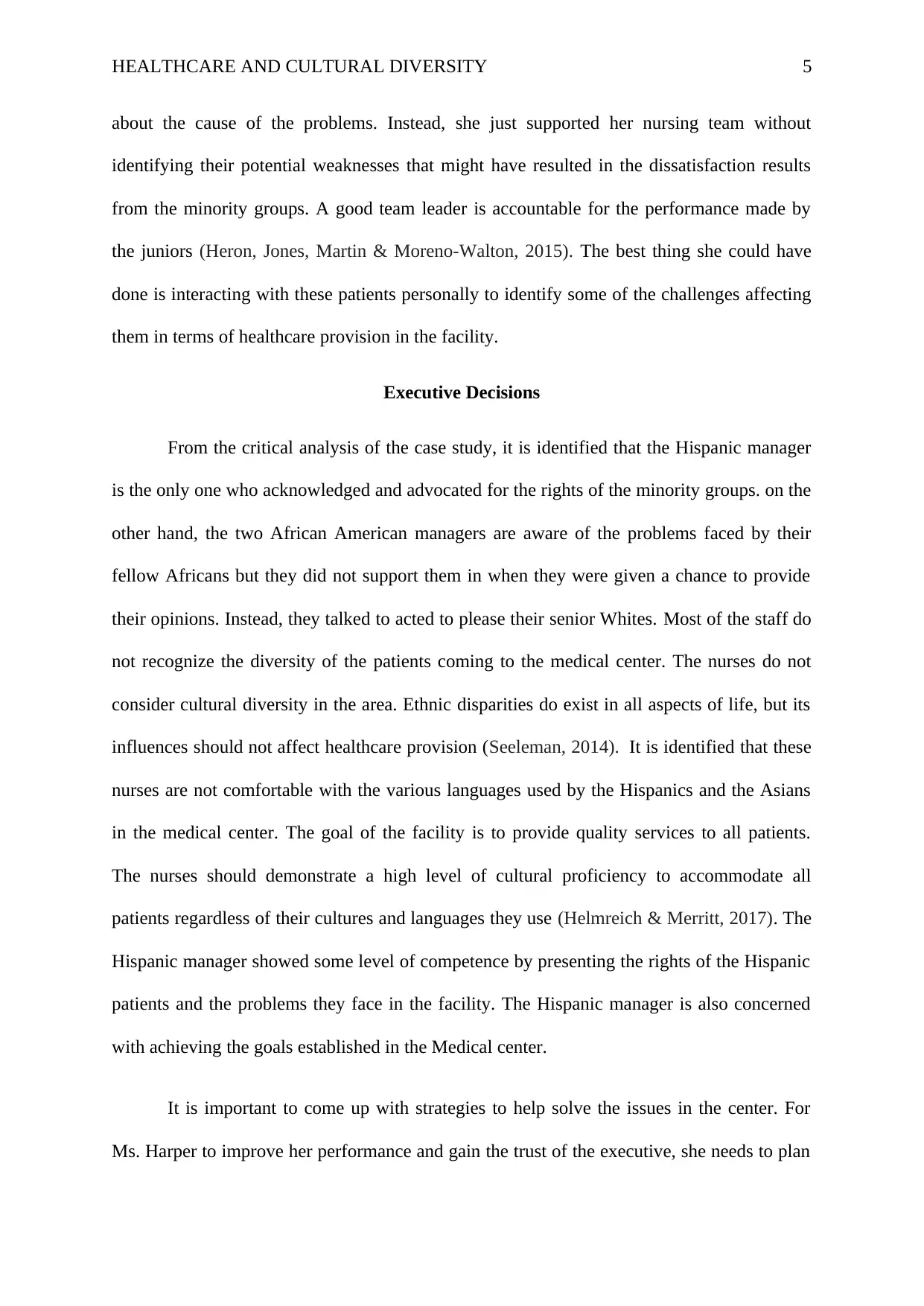
HEALTHCARE AND CULTURAL DIVERSITY 5
about the cause of the problems. Instead, she just supported her nursing team without
identifying their potential weaknesses that might have resulted in the dissatisfaction results
from the minority groups. A good team leader is accountable for the performance made by
the juniors (Heron, Jones, Martin & Moreno-Walton, 2015). The best thing she could have
done is interacting with these patients personally to identify some of the challenges affecting
them in terms of healthcare provision in the facility.
Executive Decisions
From the critical analysis of the case study, it is identified that the Hispanic manager
is the only one who acknowledged and advocated for the rights of the minority groups. on the
other hand, the two African American managers are aware of the problems faced by their
fellow Africans but they did not support them in when they were given a chance to provide
their opinions. Instead, they talked to acted to please their senior Whites. Most of the staff do
not recognize the diversity of the patients coming to the medical center. The nurses do not
consider cultural diversity in the area. Ethnic disparities do exist in all aspects of life, but its
influences should not affect healthcare provision (Seeleman, 2014). It is identified that these
nurses are not comfortable with the various languages used by the Hispanics and the Asians
in the medical center. The goal of the facility is to provide quality services to all patients.
The nurses should demonstrate a high level of cultural proficiency to accommodate all
patients regardless of their cultures and languages they use (Helmreich & Merritt, 2017). The
Hispanic manager showed some level of competence by presenting the rights of the Hispanic
patients and the problems they face in the facility. The Hispanic manager is also concerned
with achieving the goals established in the Medical center.
It is important to come up with strategies to help solve the issues in the center. For
Ms. Harper to improve her performance and gain the trust of the executive, she needs to plan
about the cause of the problems. Instead, she just supported her nursing team without
identifying their potential weaknesses that might have resulted in the dissatisfaction results
from the minority groups. A good team leader is accountable for the performance made by
the juniors (Heron, Jones, Martin & Moreno-Walton, 2015). The best thing she could have
done is interacting with these patients personally to identify some of the challenges affecting
them in terms of healthcare provision in the facility.
Executive Decisions
From the critical analysis of the case study, it is identified that the Hispanic manager
is the only one who acknowledged and advocated for the rights of the minority groups. on the
other hand, the two African American managers are aware of the problems faced by their
fellow Africans but they did not support them in when they were given a chance to provide
their opinions. Instead, they talked to acted to please their senior Whites. Most of the staff do
not recognize the diversity of the patients coming to the medical center. The nurses do not
consider cultural diversity in the area. Ethnic disparities do exist in all aspects of life, but its
influences should not affect healthcare provision (Seeleman, 2014). It is identified that these
nurses are not comfortable with the various languages used by the Hispanics and the Asians
in the medical center. The goal of the facility is to provide quality services to all patients.
The nurses should demonstrate a high level of cultural proficiency to accommodate all
patients regardless of their cultures and languages they use (Helmreich & Merritt, 2017). The
Hispanic manager showed some level of competence by presenting the rights of the Hispanic
patients and the problems they face in the facility. The Hispanic manager is also concerned
with achieving the goals established in the Medical center.
It is important to come up with strategies to help solve the issues in the center. For
Ms. Harper to improve her performance and gain the trust of the executive, she needs to plan
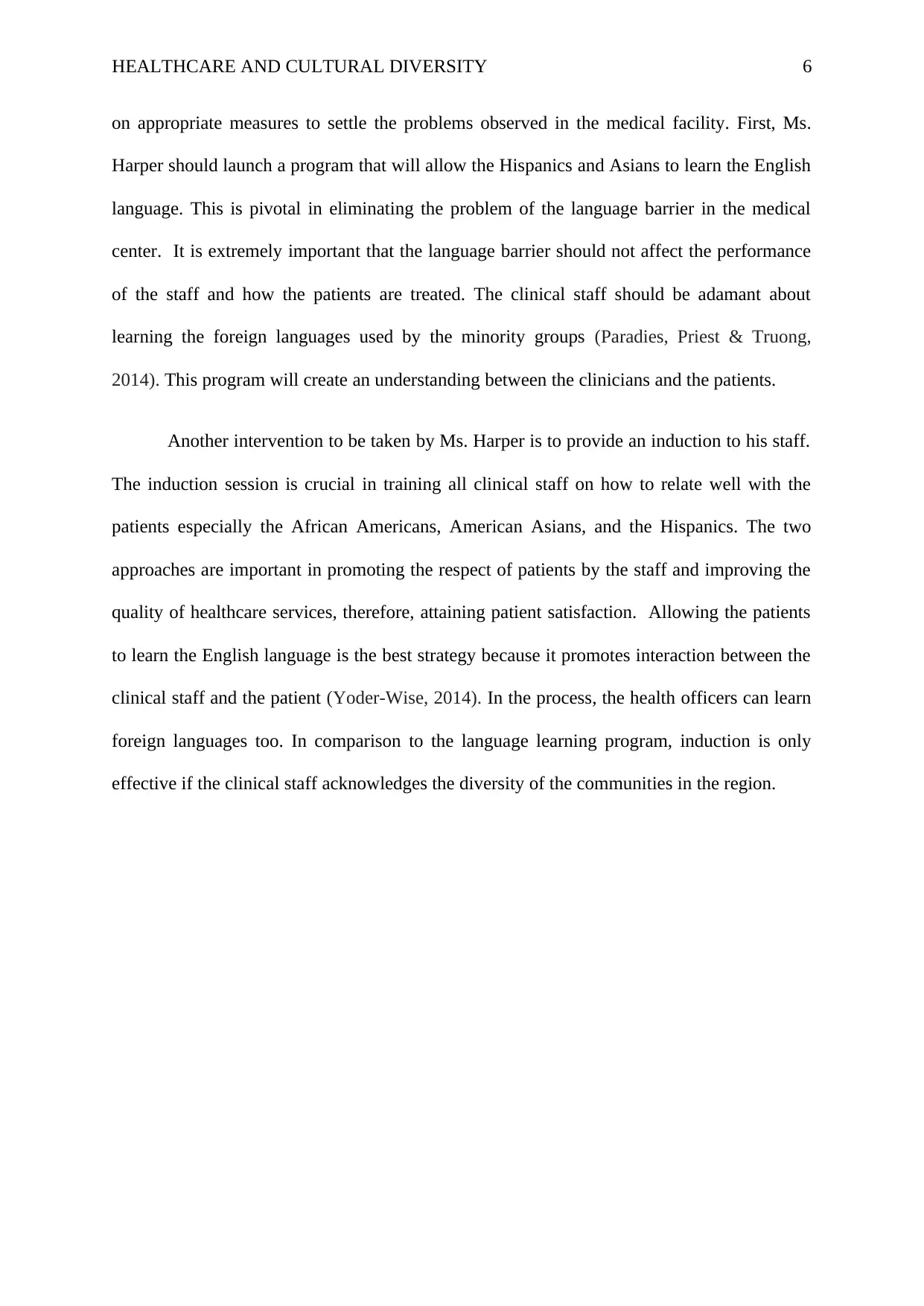
HEALTHCARE AND CULTURAL DIVERSITY 6
on appropriate measures to settle the problems observed in the medical facility. First, Ms.
Harper should launch a program that will allow the Hispanics and Asians to learn the English
language. This is pivotal in eliminating the problem of the language barrier in the medical
center. It is extremely important that the language barrier should not affect the performance
of the staff and how the patients are treated. The clinical staff should be adamant about
learning the foreign languages used by the minority groups (Paradies, Priest & Truong,
2014). This program will create an understanding between the clinicians and the patients.
Another intervention to be taken by Ms. Harper is to provide an induction to his staff.
The induction session is crucial in training all clinical staff on how to relate well with the
patients especially the African Americans, American Asians, and the Hispanics. The two
approaches are important in promoting the respect of patients by the staff and improving the
quality of healthcare services, therefore, attaining patient satisfaction. Allowing the patients
to learn the English language is the best strategy because it promotes interaction between the
clinical staff and the patient (Yoder-Wise, 2014). In the process, the health officers can learn
foreign languages too. In comparison to the language learning program, induction is only
effective if the clinical staff acknowledges the diversity of the communities in the region.
on appropriate measures to settle the problems observed in the medical facility. First, Ms.
Harper should launch a program that will allow the Hispanics and Asians to learn the English
language. This is pivotal in eliminating the problem of the language barrier in the medical
center. It is extremely important that the language barrier should not affect the performance
of the staff and how the patients are treated. The clinical staff should be adamant about
learning the foreign languages used by the minority groups (Paradies, Priest & Truong,
2014). This program will create an understanding between the clinicians and the patients.
Another intervention to be taken by Ms. Harper is to provide an induction to his staff.
The induction session is crucial in training all clinical staff on how to relate well with the
patients especially the African Americans, American Asians, and the Hispanics. The two
approaches are important in promoting the respect of patients by the staff and improving the
quality of healthcare services, therefore, attaining patient satisfaction. Allowing the patients
to learn the English language is the best strategy because it promotes interaction between the
clinical staff and the patient (Yoder-Wise, 2014). In the process, the health officers can learn
foreign languages too. In comparison to the language learning program, induction is only
effective if the clinical staff acknowledges the diversity of the communities in the region.
⊘ This is a preview!⊘
Do you want full access?
Subscribe today to unlock all pages.

Trusted by 1+ million students worldwide
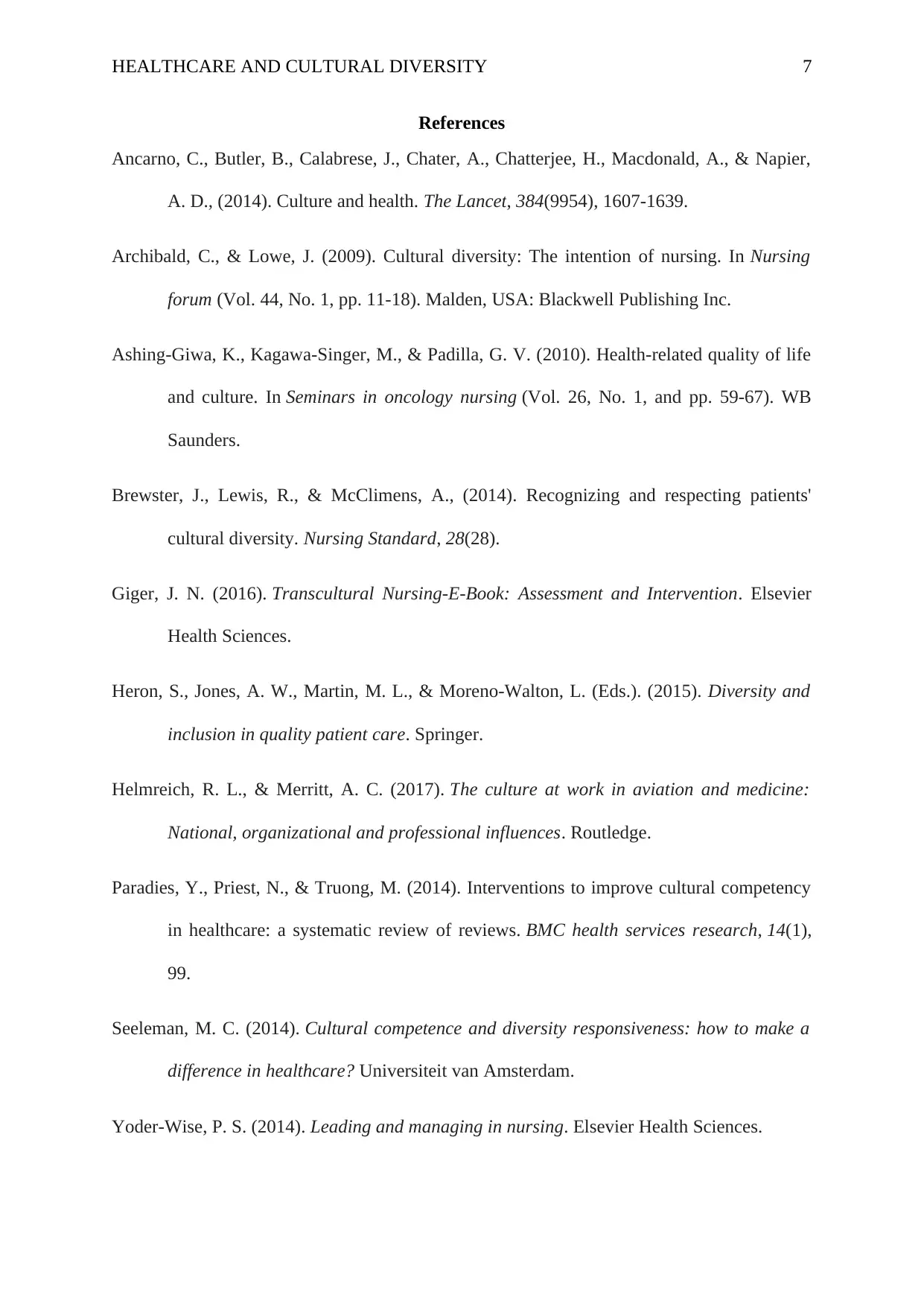
HEALTHCARE AND CULTURAL DIVERSITY 7
References
Ancarno, C., Butler, B., Calabrese, J., Chater, A., Chatterjee, H., Macdonald, A., & Napier,
A. D., (2014). Culture and health. The Lancet, 384(9954), 1607-1639.
Archibald, C., & Lowe, J. (2009). Cultural diversity: The intention of nursing. In Nursing
forum (Vol. 44, No. 1, pp. 11-18). Malden, USA: Blackwell Publishing Inc.
Ashing-Giwa, K., Kagawa-Singer, M., & Padilla, G. V. (2010). Health-related quality of life
and culture. In Seminars in oncology nursing (Vol. 26, No. 1, and pp. 59-67). WB
Saunders.
Brewster, J., Lewis, R., & McClimens, A., (2014). Recognizing and respecting patients'
cultural diversity. Nursing Standard, 28(28).
Giger, J. N. (2016). Transcultural Nursing-E-Book: Assessment and Intervention. Elsevier
Health Sciences.
Heron, S., Jones, A. W., Martin, M. L., & Moreno-Walton, L. (Eds.). (2015). Diversity and
inclusion in quality patient care. Springer.
Helmreich, R. L., & Merritt, A. C. (2017). The culture at work in aviation and medicine:
National, organizational and professional influences. Routledge.
Paradies, Y., Priest, N., & Truong, M. (2014). Interventions to improve cultural competency
in healthcare: a systematic review of reviews. BMC health services research, 14(1),
99.
Seeleman, M. C. (2014). Cultural competence and diversity responsiveness: how to make a
difference in healthcare? Universiteit van Amsterdam.
Yoder-Wise, P. S. (2014). Leading and managing in nursing. Elsevier Health Sciences.
References
Ancarno, C., Butler, B., Calabrese, J., Chater, A., Chatterjee, H., Macdonald, A., & Napier,
A. D., (2014). Culture and health. The Lancet, 384(9954), 1607-1639.
Archibald, C., & Lowe, J. (2009). Cultural diversity: The intention of nursing. In Nursing
forum (Vol. 44, No. 1, pp. 11-18). Malden, USA: Blackwell Publishing Inc.
Ashing-Giwa, K., Kagawa-Singer, M., & Padilla, G. V. (2010). Health-related quality of life
and culture. In Seminars in oncology nursing (Vol. 26, No. 1, and pp. 59-67). WB
Saunders.
Brewster, J., Lewis, R., & McClimens, A., (2014). Recognizing and respecting patients'
cultural diversity. Nursing Standard, 28(28).
Giger, J. N. (2016). Transcultural Nursing-E-Book: Assessment and Intervention. Elsevier
Health Sciences.
Heron, S., Jones, A. W., Martin, M. L., & Moreno-Walton, L. (Eds.). (2015). Diversity and
inclusion in quality patient care. Springer.
Helmreich, R. L., & Merritt, A. C. (2017). The culture at work in aviation and medicine:
National, organizational and professional influences. Routledge.
Paradies, Y., Priest, N., & Truong, M. (2014). Interventions to improve cultural competency
in healthcare: a systematic review of reviews. BMC health services research, 14(1),
99.
Seeleman, M. C. (2014). Cultural competence and diversity responsiveness: how to make a
difference in healthcare? Universiteit van Amsterdam.
Yoder-Wise, P. S. (2014). Leading and managing in nursing. Elsevier Health Sciences.
1 out of 7
Your All-in-One AI-Powered Toolkit for Academic Success.
+13062052269
info@desklib.com
Available 24*7 on WhatsApp / Email
![[object Object]](/_next/static/media/star-bottom.7253800d.svg)
Unlock your academic potential
Copyright © 2020–2025 A2Z Services. All Rights Reserved. Developed and managed by ZUCOL.